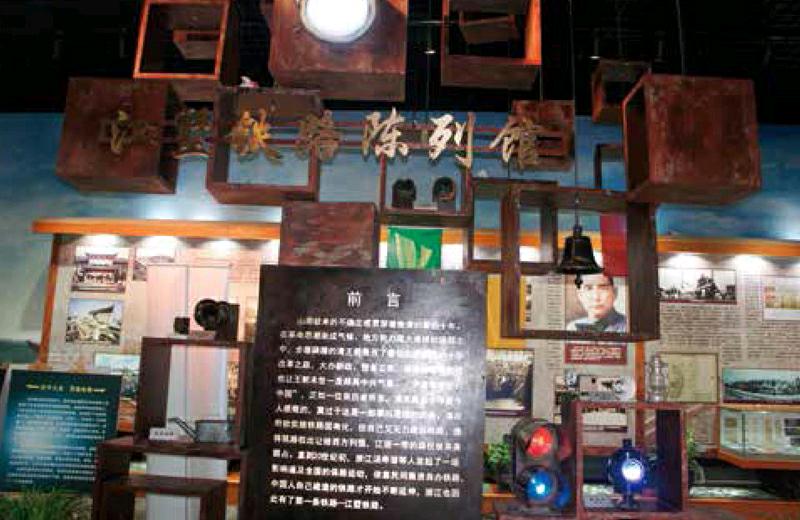长中国人志气的江墅铁路
水清浅
上世纪初,火车尚属稀奇事物,杭州建造了浙江第一条铁路——江墅铁路。据书刊回忆,当年沿线的老杭州人,每有蒸汽火车途经时,总在铁轨两旁惊奇地看着那庞然大物隆隆而行,嘴里发出啧啧之声。
江墅铁路早已不复存在,如今我们只能在遗址公园内怀想当年的盛况。初秋一个下雨的午后,笔者在遗址公园管理员兼讲解员刘美玲志愿者的陪同下,开启了一段寻踪之旅。
一
江墅铁路遗址公园在杭州拱墅区的登云路和金华路口,这是浙江近代工业进程、百年铁路事业发展的一个缩影。遗址公园内新建有高高的钟楼,新铺有长长的铁轨,铁轨上停放着老式的火车头。其中,最具本色的,应当是按照历史原貌复建的半东方半西方式的拱宸桥候车室,充满缅想怀旧的浓郁风情。
铁路初期的候车室没什么畅达宏伟,不具备时代特征,现在复建,是作为陈列馆。这里面的内容不仅有关于江墅铁路的文字和图片的详细介绍,而且有铁路发展各时期的铁轨、枕木、道叉、铜钟、信号灯、车头喇叭、修理工具和地图、火车票、员工制服等珍贵实物,以及火车模型,展陈布置得合理且有艺术性。
看着这些满满当当、富有年代感的展品,又听着刘美玲的串讲,江墅铁路几十年的历程仿佛就展现在笔者眼前。
风雨飘摇的19、20世纪之交,西方列强加紧了对中国各种资源的大肆掠夺。1898年9月(光绪二十四年),晚清政府以向英商怡和洋行借款为由,再次接受英国提议的在中国修建包括苏杭甬铁路在内的5条铁路的要求并签约。
消息传出,社会震动,人们要求废除不平等条约,一批爱国人士和进步青年多次提出抗议:“我们的铁路,为什么要西方列强修建?”并于1905年7月成立浙江首个商办铁路有限公司,聘请挂职两淮盐运使的立宪派人物、浙江萧山人汤寿潜为公司总经理,发动了一场影响遍及全国的保路运动。迫于民情舆论的压力,晚清政府同意收回铁路筑路权。
1906年5月,汤寿潜等人为了早日筹措到修建浙江铁路的资金,打出“工商各界、缩衣节食、勉尽公义”的口号,鼓动各界人士积极认购股份。其时,浙江南浔人刘锦藻、庞元济,德清人周庆云等民族资本家纷纷解囊成为主要股东。社会民众像工人、商贩、农民、伶人、苦力以及僧道,甚至乞丐等,也加入了认购股份的队伍。由此可见,老百姓对中国人自己修建铁路非常支持。
二
浙江铁路有限公司最初设想和江苏共建苏沪杭甬之间的铁路,但因资金有限,最后决定先在杭州市区内造一条连接钱塘江与大运河的铁路。
说起这铁路走向的故事,颇有意思。专家曾提出两个备选方案:第一是绕西湖而行,第二是沿杭州老城墙而行。因前者须越过万松岭,沿线要迁许多坟墓,牵扯面浩大,同时也势必破坏西湖景观,所以,浙江铁路有限公司选择了后者,即从江干的闸口出发,沿南星桥、清泰门、艮山门抵湖墅的拱宸桥,共5个站点,取名“江墅铁路”。现在我们能否猜想,如若选择第一种方案,西湖会是哪般模样?杭城会有哪种格局?
1906年11月14日,江墅铁路终于在万众期待中动工;不到一年时间,全线竣工;1907年8月23日,运营开通。江墅铁路全长16.135公里,坦坦荡荡,没有山川阻隔,但在当时确是杭州乃至浙江一件很了不起的事情。为纪念通车的日子,遗址公园特意在原貌仿造的候车室即陈列馆的门楣上方,增设了显眼的“1907.8.23”数字。
再说一个车站的故事。1909年,江墅铁路和杭嘉铁路(杭州至枫泾)联通。有一次,汤寿潜的女婿马一浮从外地乘火车回杭,到家大大超出预计时间,这并非火车晚点,而是因为从清泰门站步行进城的路途太长。马一浮说,杭州的火车站都设在城外,要是赶早班、末班火车,非常不方便。女婿的话促使岳父思考:为什么不能把火车站设在交通便捷的城内?
很快,汤寿潜把这一想法向朝廷禀明,得到批复后,立即组织人员以最快的速度把清泰门站移到了老城门处,江墅铁路也随之改道。因为这是杭州唯一的城内的火车站,便称之为“城站”,一直沿用至今。
江墅铁路一度成为杭城最主要的交通线。辛亥之后,孙中山来杭州考察,三天的停留中,他专门踏勘了江墅铁路,并全程乘坐火车体验。资料显示,1937年前的拱宸站,年进出旅客近60万人次。
三
1944年,侵华日军把江墅铁路艮山门至拱宸桥段的铁轨拆得一根不剩。拆除后的铁路路基改筑成了马路,即现在的绍兴路。笔者万万没想到,常常经过的绍兴路,70多年前竟是沧桑历史的一部分。
使用至今的江墅铁路艮山门至闸口段,在抗战全面爆发之前已连接、归入沪杭铁路、浙赣铁路。新中国成立后,留存的火车站各自承担使命:闸口站作为货场使用,现在已搬迁,部分用地改扩建为闸口白塔公园,里面有若干遗址遺物;南星桥站是编组站,如今成了货运站;城站一直是杭州火车站,虽有多次重建,但保留着旧迹遗痕;而艮山门站从来未变,是车辆的调度枢纽站点之一。
历史就是用来回望的。2006年,江墅铁路遗址公园在江墅铁路终点站的地方开始打造,2008年10月建成开放;2013年1月,遗址公园内的陈列馆正式对外开放。
笔者到遗址公园采访的那个下午,滂沱大雨不曾停歇,然而这并没有浇灭游客的热情。短短两个多小时,志愿者刘美玲接待了五六拨客人。她是一名退休英语教师,自陈列馆开馆以来,每个周三至周日,从早上九点至下午四点半,一刻不离地等候,见证了陈列馆从冷冷清清到热热闹闹的过程。
刘美玲告诉笔者,目前自发前来参观的市民占绝大多数,外地组团来的游客也不少,部分大中小学校常会组织学生过来,一些铁路工作者和专家学者常来调研考察。最令刘美玲欣喜的是,每个月她都会接待到十批左右外国游客,而这正好可以发挥英语专长。老外关注江墅铁路,让刘美玲很意外,好多时候,她会向老外补充介绍大运河和湖墅的历史文化。俨然,江墅铁路遗址公园已成为杭州对外展示的一个窗口。endprint
走出陳列馆,天色渐暗,遗址公园里仍有情侣在中国现代化进程中作为转折点标识的蒸汽火车头旁拍照留念。是的,这条长中国人志气的江墅铁路被后人牢记在心。
The first railroad in Zhejiang province was a city railroad just outside the now-nonexistent city wall of Hangzhou, but back then the old city was small. The 16.135-km railroad began operating on August 23, 1907. At one end was Jianggan District and at the other was Gongshu District, and that is how the railway was called Jiang-Shu railway.
Early in the 20th century, most people in Hangzhou had never seen a train. Back then, people would stop moving and stand gaping at a locomotive with a long train of cars chugging past, roaring and letting off steam. The city railway as a whole system is no more. It has long since merged into a much bigger system.
In July 1905, Zhejiang Railway Company came into being in Hangzhou to build railways in Zhejiang. The company was headed by Tang Shouqian. In May 1906, it began to raise funds from the public. The right to build a railway in China didnt come easily. The right had been given away to foreigners before. But the right came back after the whole nation rose to protest. The public in Zhejiang contributed enthusiastically. Major stockholders included some business tycoons, but ordinary people bought stocks, too, including factory workers, merchants and peddlers, farmers, entertainers, laborers, religious people, and even some beggars.
Zhejiang Railway at first wanted to join hands with Jiangsu Province to build a railway that would connect Suzhou, Shanghai, Hangzhou and Ningbo. The initiative was put on backburners because of inadequate funds. Less ambitious, the company decided to build a railway that connected Qiantang River and the Grand Canal of China, at either side of Hangzhou. Two blueprints were prepared for the first railway. One was to build a railway that circled the West Lake. The second plan was to build a railway just outside the city wall to the east. The first plan was soon given up, as the railroad would have to climb up a hill and a lot of tombs would have to be relocated, let along the possible damage to the scenic lake zone.
Construction started on November 13, 1906. In less than a year, the railway was concluded. The railway had five stations from south to the north: Zhakou in district on the northern bank of Qiantang River, Nanxing Bridge, Qingtai Gate, Genshan Gate, and Gongcheng Bridge at the northern end where the Grand Canal started.
In 1909, Jiang-Shu Railway connected with Hang-Jia (Hangzhou-Fengjing) Railway and allowed Hangzhou residents to travel to Shanghai by train. One small inconvenience of the railway system was that the five stations outside the city wall were not easy to access for local residents inside the city. After the approval of the central government, the route was slightly modified and a new station was built inside the city. It was called City Station. Though the original station structure has been rebuilt several times since then and though the city now has a brand new and much spacious passenger railway hub in the northeastern part of the city, the small and convenient station in the heart of the city remains in operation and it is still called City Station.endprint
For decades, the railway was a major transport route of the city. The historical data indicates that Gongcheng Bridge station alone registered nearly 600,000 departures and arrivals in 1937. During his three-day visit to Hangzhou after the 1911 Revolution, Dr. Sun Yat-sen inspected the railway and took a ride through all the five stations.
During World War II, the section of the railway between Genshan Gate and Gongcheng Bridge was dismantled by the Japanese occupiers. The section from Genshan Gate to Zhakou is still operational. Before World War II, the railway had already connected with Shanghai-Hangzhou (Hu-Hang) Railway to the north and with Zhejiang-Jiangxi (Zhe-Gan) Railway to the southwest. Zhakou Gate Station was used as a cargo and warehouse terminal for a long time. Part of the station is now White Pagoda Park. Nanxing Bridge Station is now a freight center. City Station remains in downtown Hangzhou as a passenger center. Genshan Gate Station, a few kilometers north of the City Station, remains as a switching yard.
Though whats known as Jiang-Shu Railway is long gone, the Jiang-Shu Railway Park in Hangzhou honors its past glory and memory. The park sits at the site of the original Gongcheng Bridge station. It opened to the public in October 2008. In January 2013, an exhibition hall on the site began to receive visitors. Nowadays, it attracts quite a few visitors. Most visitors are local and many are school students. It also attracts experts and historians. Averagely, about ten foreign tourist groups come to visit the park every month.endprint

